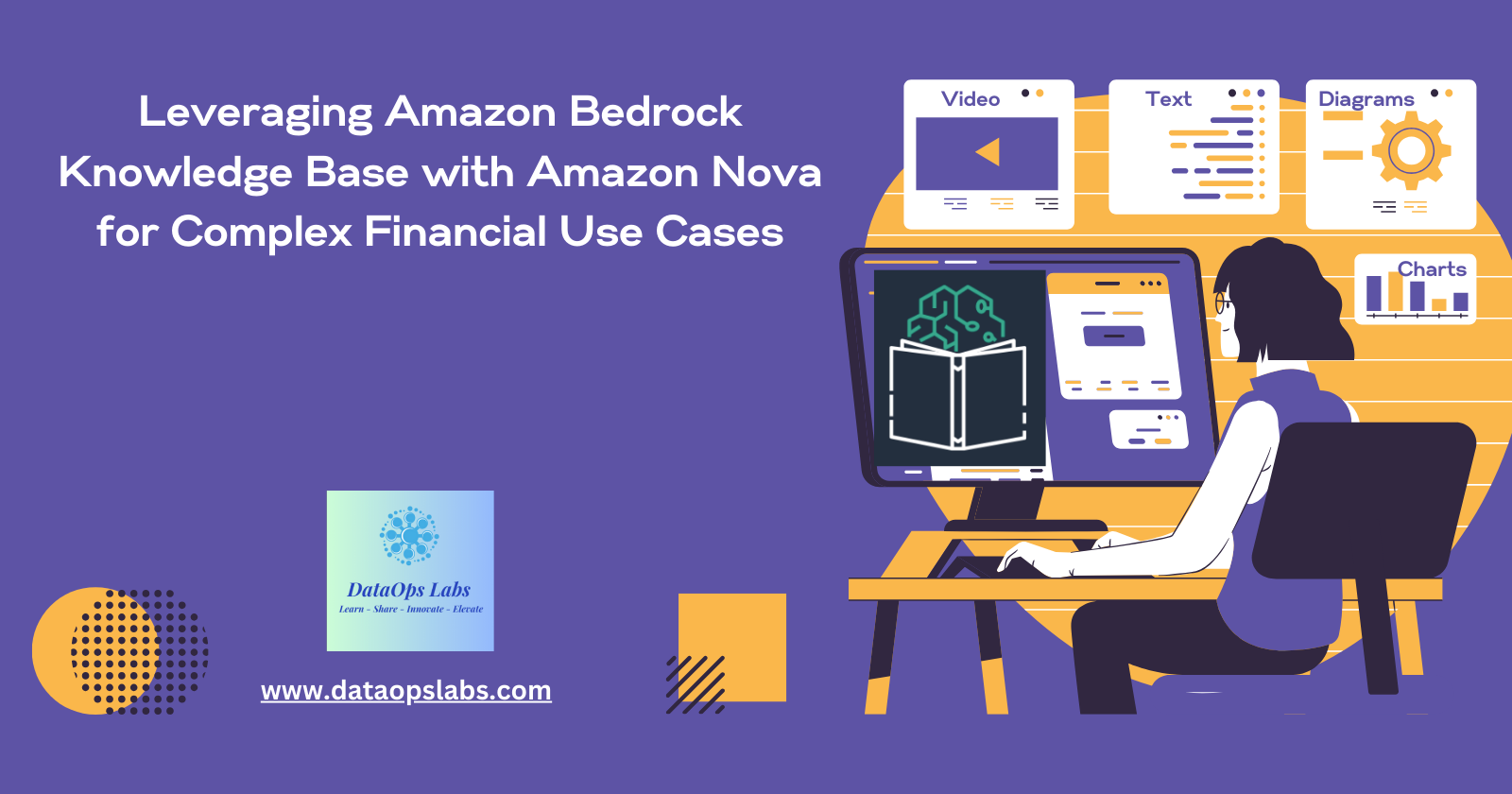Leveraging Amazon Bedrock Knowledge Base with Amazon Nova for Complex Financial Use Cases
 DataOps Labs
DataOps Labs
Introduction
In the fast-paced world of finance, data is the backbone of innovation. Financial institutions rely on data-driven insights to recommend products, assess risks, and enhance customer experiences. Amazon Bedrock Knowledge Bases offer a powerful platform for building Retrieval-Augmented Generation (RAG) applications that unlock the full potential of structured and unstructured data.
This blog delves into how Amazon Bedrock Knowledge Bases empower financial use cases with advanced retrieval methods like GraphRAG, structured data retrieval (NL2SQL), and multimodal data processing, all while enabling secure, scalable, and efficient workflows.
What is Retrieval-Augmented Generation (RAG)?
Retrieval-Augmented Generation (RAG) combines the capabilities of knowledge retrieval and natural language generation. With RAG, foundational models (FMs) are augmented by external data to provide relevant, contextually rich, and actionable outputs.
Key Components:
Retrieval: Fetch relevant data from external knowledge bases or sources.
Augmentation: Integrate the retrieved data into prompts for foundational models.
Generation: Use the augmented prompts to produce responses tailored to the user's needs.
Amazon Bedrock Knowledge Bases streamline this process with native features, including secure data connectors, hybrid search, and metadata filtering, ensuring high-quality outputs.
Key Features of Amazon Bedrock Knowledge Bases
1. Hybrid Search
Bedrock supports hierarchical, semantic, and custom chunking strategies, enabling precise and efficient retrieval across diverse data sources. This is crucial for financial institutions managing both structured (e.g., transactional data) and unstructured (e.g., compliance documents) datasets.
2. Structured Data Retrieval (NL2SQL)
Translate natural language queries into SQL to access structured data seamlessly. This feature is invaluable for financial analysts who need real-time insights from relational databases like Amazon Redshift or SageMaker Lakehouse.
Example:
Query: "What was the top-selling financial product in Q4 2024?"
Response:
Retrieve sales data from structured repositories.
Generate an SQL query for detailed insights.
3. GraphRAG
Leverage knowledge graphs to map relationships between financial entities, such as customers, transactions, and products. This feature enhances transparency and allows for more sophisticated risk assessments and compliance monitoring.
Example Use Case: Detecting fraudulent activity by analyzing unusual transaction patterns or relationships between entities in a financial ecosystem.
4. Multimodal Data Processing
Process text, images, and tables in tandem, making it easier to generate comprehensive reports or respond to complex queries. This is particularly useful for visualizing financial trends and performance metrics.
Use Cases in Finance
1. Product Recommendations
Challenge: Providing tailored product recommendations based on customer profiles and behaviors.
Solution:
Use GraphRAG to identify patterns and relationships within customer data.
Augment recommendations with relevant insights from structured data retrieval.
Impact: Higher customer satisfaction and conversion rates.
2. Risk Assessment
Challenge: Evaluating risks for loan approvals or credit underwriting.
Solution:
Analyze transaction histories and credit scores using structured data retrieval.
Combine this with GraphRAG for contextual insights into customer relationships and financial stability.
Impact: Reduced default rates and improved decision-making accuracy.
3. Compliance and Fraud Detection
Challenge: Ensuring regulatory compliance and identifying fraudulent activities.
Solution:
Leverage GraphRAG to map relationships and detect anomalies.
Use Bedrock’s real-time synchronization to stay updated with compliance guidelines.
Impact: Enhanced transparency and minimized legal risks.
Advanced Techniques for Bedrock Knowledge Bases
Combining Structured Retrieval and GraphRAG
By combining structured SQL-based retrieval with graph-based analysis, financial institutions can achieve a comprehensive understanding of both data trends and entity relationships.
Optimized RAG Workflows
Bedrock’s prebuilt workflows for ingestion, retrieval, and augmentation simplify the deployment of RAG applications. Built-in session context management enables seamless multi-turn interactions, essential for customer support or advisory services.
Real-Time Sync
Stay updated with live market data and compliance regulations using Bedrock’s real-time synchronization capabilities, ensuring timely and accurate decision-making.
Comparison: GraphRAG vs. Structured Data Retrieval
| Aspect | GraphRAG | Structured Data Retrieval (NL2SQL) |
| Primary Use Case | Mapping relationships, fraud detection | Precise queries, transactional analysis |
| Data Type | Unstructured or semi-structured | Structured (relational databases) |
| Advantages | Transparency, contextual insights | Scalability, efficiency, real-time updates |
| Limitations | Requires predefined knowledge graphs | Limited ability to infer relationships |
Methodology for Scalable Financial RAG Applications
Start Small: Build proof-of-concept projects using Bedrock’s native workflows.
Optimize Data Preparation: Use metadata filtering and chunking strategies for efficient ingestion.
Model Selection: Choose foundational models that align with financial tasks.
Deploy and Monitor: Leverage Bedrock’s evaluation tools and hybrid search capabilities for continuous improvement.
Conclusion
Amazon Bedrock Knowledge Bases provide a robust platform for financial institutions to unlock actionable insights from their data. With advanced features like GraphRAG, structured data retrieval, and multimodal processing, Bedrock empowers organizations to enhance product recommendations, streamline compliance, and optimize risk assessments.
Whether you're a financial analyst or a decision-maker, Bedrock Knowledge Bases offer the tools to navigate today’s complex data landscape with precision and confidence.
Call to Action:
Ready to transform your financial Agentic AI workflows? Explore Amazon Bedrock Knowledge Bases with Agents today and unlock the future of scalable RAG applications.
Subscribe to my newsletter
Read articles from DataOps Labs directly inside your inbox. Subscribe to the newsletter, and don't miss out.
Written by

DataOps Labs
DataOps Labs
I'm Ayyanar Jeyakrishnan ; aka AJ. With over 18 years in IT, I'm a passionate Multi-Cloud Architect specialising in crafting scalable and efficient cloud solutions. I've successfully designed and implemented multi-cloud architectures for diverse organisations, harnessing AWS, Azure, and GCP. My track record includes delivering Machine Learning and Data Platform projects with a focus on high availability, security, and scalability. I'm a proponent of DevOps and MLOps methodologies, accelerating development and deployment. I actively engage with the tech community, sharing knowledge in sessions, conferences, and mentoring programs. Constantly learning and pursuing certifications, I provide cutting-edge solutions to drive success in the evolving cloud and AI/ML landscape.